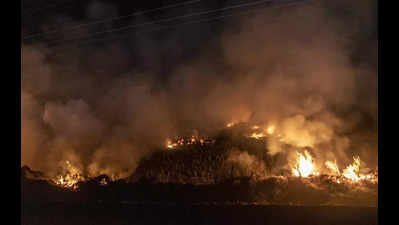
Gurgaon: Are measures to cut down farm fires working? There are indications, but it’s still too early to conclude, experts said on Sunday.
The count of farm fires in Haryana was up from the previous years till mid-October, but the trend appears to have changed directions since, as fewer incidents of stubble burning are being recorded in the state in the last ten days.
According to satellite data collated by the Indian Agricultural Research Institute, Haryana did not record any active fire locations (AFLs) in September before 2023. Last year, it reported 75 AFLs over the month, and 81 this year.
From Sept 15 till Oct 15, 559 active fire locations (AFLs) were traced in Haryana this year. This count was slightly lower from farm fires seen in the same period last year, but a larger gap from 168 AFLs reported in 2022.
Experts said it’s possible that farmers started clearing tracts of land early this year because of lack of rainfall in September and early October compared to the previous years.
Data from Oct 16 shows a declining trend in the number of farm fires.
Between Oct 16 and Oct 26, the state recorded 141 farm fires, a 64% decline from 396 reported in the same timeframe last year. It was also a 90% decline from 1,471 AFLs reported in the duration in 2020.
“September this year experienced less rainfall compared to the last four years, leading to an early onset of farm fires. Consequently, fires were dispersed over a larger number of days rather than being concentrated towards the end of October, as was previously the case,” said Shubhansh Tiwari, a research associate at the Centre for Science and Environment (CSE).
Tiwari said the overall count of farm fires may indicate that farmers in the state were adopting new technologies to manage paddy stubble, and/or were deterred from setting alight their fields due to surveillance from authorities.
“The current numbers indicate that this year could potentially see the least active stubble burning season in the past four years. But predictions can be wrong, and it could still turn out to be an entirely different year. Moreover, these numbers are derived from satellite data, and the ground situation might be different,” he said.
On air quality in Delhi-NCR still being poor, Tiwari said farm fires were not the only cause of pollution in the region. “Air quality of Delhi-NCR is a complex issue, and it is not solely dependent on farm fires. Each component needs to be addressed to effectively tackle pollution,” he added.
Officials of Haryana’s agriculture department told TOI that sowing on 50% of fields for the next round of crops is already over in the state.
“We expect the number of farm fires to be the lowest this year. It’s because of improved agricultural practices, increased awareness among farmers, and effective interventions aimed at mitigating fire risks during the harvest season,” an official said.
But experts cautioned that it was premature to draw conclusions as farm fires are likely to increase from Nov 1.
“The worst is yet to come. Based on my observations, the region typically experiences peak burning in Haryana from Nov 5 onwards, sometimes extending into the second week. Yesterday (Oct 26), the PM 2.5 contribution from stubble burning in Delhi was 14.6%, and this is likely to rise to 30-40% after Diwali,” said Manoj Kumar, an analyst at Research and Energy for Clean Air (CREA).

